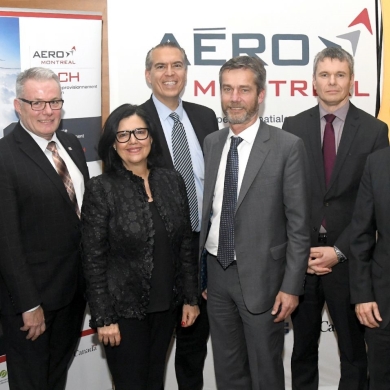29 janvier 2020
Laflamme Aéro reçoit 2 millions de dollars en capital de risque
Un produit novateur développé au Québec Saint-Joseph-de-Coleraine, 29 janvier 2019 — L'entreprise Laflamme Aéro, située dans la région de Thetford Mines, annonce la conclusion d'une ronde de financement de 2 millions de dollars à laquelle participent Investissement Québec, Anges Québec et Anges Québec Capital. Des investissements qui tombent à point pour l'entreprise qui s'apprête à commercialiser son drone LX300 dès 2020, le premier appareil au monde de type hélicoptère sans pilote capable de transporter des charges de 90 kilos. « Le LX300 est l'un des plus gros drones civils au monde. Avec ses 300 kilos, il se distingue principalement par sa polyvalence, sa capacité à transporter de lourdes charges et son autonomie de vol de huit heures. Cet investissement de 2 millions de dollars nous permet à présent de propulser et de faire connaître notre produit vers les grands marchés nationaux et internationaux », explique Enrick Laflamme, ingénieur, cofondateur et président de Laflamme Aéro, entreprise qu'il a fondée avec son frère David également ingénieur et vice-président ingénierie de l'entreprise en pleine croissance. Outre le déploiement commercial du LX300, les nouveaux investissements annoncés aujourd'hui permettront de soutenir l'amélioration des infrastructures de l'entreprise et l'implantation d'une chaîne de montage, l'ajout de nouvelles ressources pour soutenir la croissance de Laflamme Aéro, ainsi que la continuité en recherche et développement de nouveaux produits. Développé par l'entreprise familiale depuis 2013, le LX300 est un produit novateur destiné tant aux secteurs privé que commercial, militaire ou gouvernemental. Très versatile, l'appareil peut être muni de caméras de surveillance ou encore transporter du matériel sur de longues distances, pour approvisionner un secteur difficilement accessible par exemple. Le LX300 a relevé avec succès les nombreux essais en vol et autres manœuvres délicates de décollages et d'atterrissages au cours des deux dernières années. « Il a tous les avantages d'un hélicoptère, mais sans avoir besoin d'un pilote. Il est muni d'un système de rotor en tandem (deux hélices), permettant le décollage et l'atterrissage à la verticale et une grande stabilité. Tous ces éléments et la qualité de conception en font un produit extrêmement fiable et dont les coûts opérationnels sont compétitifs », ajoute M. Laflamme. Soutenir l'innovation en région « Laflamme Aéro a développé une technologie efficace et unique, qui démontre l'excellence du Québec en matière d'innovation. Nous sommes fiers de soutenir une jeune entreprise aéronautique de pointe établie dans la région de Chaudière-Appalaches, afin de lui permettre d'être compétitive dans les différents secteurs ciblés afin de tirer son épingle du jeu dans un marché mondial de plusieurs milliards de dollars », soutient M. Pierre Fitzgibbon, ministre de l'Économie et de l'Innovation. « Un secteur fort compétitif comme l'aéronautique exige des investissements majeurs en recherche et développement de la part des entreprises, et ce, sur plusieurs années, avant d'en arriver au stade de précommercialisation. Dans le cadre du mandat élargi que lui confie le gouvernement, Investissement Québec entend déployer des efforts particuliers pour financer et accompagner les entreprises des régions non urbaines comme Laflamme Aéro. Nous souhaitons faire la différence afin d'atténuer les lacunes décelées lors des stades critiques où les niveaux de risque-rendement sont souvent jugés trop élevés pour intéresser certains acteurs privés », précise M. Guy LeBlanc, président-directeur général, Investissement Québec. Précisons que Laflamme Aéro bénéficie du soutien de Transport Canada dans le développement d'une certification adaptée selon les plus hauts standards, ainsi que de l'entreprise General Dynamics Mission Systems, une des plus grandes entreprises de défense et de sécurité au Canada, avec qui l'entreprise de Chaudière-Appalaches a récemment signé un accord de coopération afin de promouvoir le LX300 auprès des grands joueurs en défense et en sécurité au Canada et à l'international. À propos de Laflamme Aéro Fondée en 2006, Laflamme Aéro est une entreprise familiale située à St-Joseph-de-Coleraine dans la région de Thetford Mines au Québec dirigée par les frères David et Enrick Laflamme, tous deux ingénieurs et passionnés d'aviation. L'entreprise se spécialise dans le développement d'hélicoptères à rotors en tandem, dont le LX300 qui sera commercialisé dès 2020. Laflamme Aéro possède également une division de génie-conseil, Laflamme Ingénierie, qui réalise des projets d'ingénierie mécanique en sous-traitance pour des entreprises du secteur aérospatial, énergétique et manufacturier. À propos d'Investissement Québec Investissement Québec a pour mission de favoriser la croissance de l'investissement au Québec, contribuant ainsi au développement économique et à la création d'emplois, et ce, dans toutes les régions. La Société met au service des entreprises une gamme complète de solutions financières, notamment des prêts, des garanties de prêt et de l'investissement en capital-actions, afin de les soutenir à tous les stades de leur développement. De plus, elle est responsable de l'administration de mesures fiscales et de la prospection d'investissements à l'étranger. À propos d'Anges Québec Fondé en 2008, Anges Québec est un réseau de plus de 250 anges investisseurs qui ont pour mission d'investir et de s'investir dans des entreprises québécoises innovantes. Les membres du réseau d'Anges Québec ont, à ce jour, investi plus de 100 M$ dans l'économie québécoise, totalisant plus de 265 investissements dans plus de 137 entreprises innovantes. Gr'ce à son centre de développement professionnel, Anges Québec soutient ses membres dans l'acquisition constante de nouvelles connaissances et compétences inhérentes à l'investissement. À propos d'Anges Québec Capital Fondé en 2012, Anges Québec Capital est un fonds d'investissement de 86M$, commandité par Investissement Québec, via ses fonds propres et à titre de mandataire du Gouvernement du Québec, la Caisse de dépôt et placement du Québec (CDPQ), le Fonds de Solidarité FTQ et des membres d'Anges Québec. Il a pour mission d'accompagner les 250 membres d'Anges Québec dans leurs investissements. À ce jour, Anges Québec Capital a investi plus de 47M$ dans 53 entreprises innovantes, totalisant 112 transactions. https://www-investquebec-com.cdn.ampproject.org/c/s/www.investquebec.com/amp/quebec/fr/salle-de-presse/communiques/Laflamme-Aero-recoit-2-millions-de-dollars-en-capital-de-risque.html

